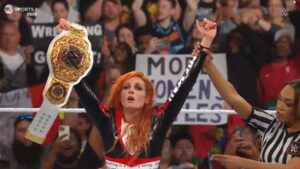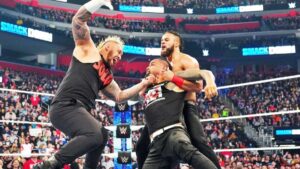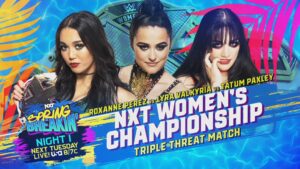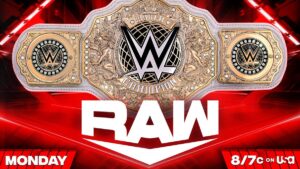For two decades, Michael Hegstrand – better known to the wrestling world as Road Warrior Hawk – was part of one of pro wrestling’s most dominant tag teams, The Road Warriors (or Legion of Doom as they were more often called in the WWE). But the story of the Road Warriors came to crashing halt on October 19, 2003, when Road Warrior Hawk was found dead in his home from a heart attack. He was 46 years old.
Michael Hegstrand grew up in St. Paul, Minnesota, where his love of power lifting created an intimidating personality. While working as a bouncer at Grandma B’s Nightclub in St. Paul, he was scouted by promoter Eddie Sharkey – in fact, Sharkey recruited four of Grandma B’s bouncers at that time, also including Road Warrior Animal, Rick Rude, and Barry Darsow (Krusher Kruschev, Demolition Smash), to become professional wrestlers. They four began training in 1983 and all four went on separate paths in the beginning of their careers, with Hegstrand heading to NWA All Star Wrestling in Vancouver as Crusher Haig. But it would be a twist of fate that would set both his and Joe Laurinaitis destiny in motion. Laurinatis was working for Ole Anderson in Georgia Championship Wrestling (GCW) and one night in June of 1983, Laurinaitis’ regular tag partner was hit with legal problems, leaving Laurinaits without a partner. Anderson called up Hegstrand and paired the two together last minute, calling them the Road Warriors. While they weren’t the dominant wrecking crew the world would grow to fear, there was clearly something special when the two – now renamed Road Warrior Hawk and Road Warrior Animal – worked together as a unit.

Paul Ellering, who had been a wrestler during the late 1970’s and early 1980’s for Jerry Jarrett‘s Continental Wrestling Association (CWA) in Memphis and in Bill Watts‘ Mid South Wrestling, was forced into retirement in 1982 following a severe knee injury. Recognizing Ellering’s talent on the mic, Ole Anderson brought him to GCW, where he formed a full stable to be called The Legion of Doom. It featured singles stars Jake “The Snake” Roberts and The Spoiler, but they needed a tag team unit and The Road Warriors fit the bill to exactly the kind of carnage Ellering had in mind. The full stable lasted only briefly, but the Legion of Doom moniker would follow Ellering and The Road Warriors for the rest of their careers interchangeably with the Road Warriors name.

It didn’t take long for Hawk and Animal to take over the tag team division of GCW. In their first full year with GCW, they were 3x NWA National Tag Team Champions, the top tag titles in GCW and one of the most respected NWA tag titles due to their frequent defenses on the legendary Saturday night program World Championship Wrestling (the show that ultimately gave WCW their brand name) on TBS at 6:05pm. In GCW, The Road Warriors had wars with the likes of The Armstrongs (Brad & Bob Armstrong), The Sawyers (Brett & Buzz Sawyer), Austin Idol & Jerry “The King” Lawler, and more.

Following a dominating year in GCW, The Road Warriors and Ellering moved back to Minnesota, joining Verne Gagne’s American Wrestling Association (AWA), and quickly won the AWA World Tag Team titles from Baron Von Raschke & The Crusher. They would go on to hold those belts for 400 days, fending off challenges from The Fabulous Ones (Stan Lane & Steve Keirn), The High Flyers (Jim Brunzell & Greg Gagne) and multiple tandems led by emerging AWA star Curt Hennig.

In 1986, they were on the move again – taking their Road Warriors moniker literally – this time joining Jim Crockett Promotions‘ NWA Mid Atlantic territory. They made a grand entrance, winning the 1986 Crockett Cup Tag Team tournament to make their grand presence known, before heading to Starrcade ’86 for their legendary scaffold match against the Midnight Express (Bobby Eaton & Dennis Condery) with manager Jim Cornette.
The Road Warriors also ran into competition against the Four Horsemen, whose Arn Anderson and Tully Blanchard were running the tag team end of things. The Road Warriors would form an alliance with Ric Flair‘s rival, Dusty Rhodes, to take on the Four Horsemen. In 1986, the trio of Rhodes, Hawk and Animal would capture the NWA World 6-Man Tag Team Championship, holding them for 636 days, as well as frequently battle the Horsemen in a steel cage – they were competitors in the first War Games at NWA Great American Bash ’87, and the war would continue over the next several installments as well.

Starting in 1985, the duo would also begin touring in Japan, working with All Japan Pro Wrestling, where their frightening power and explosive speed for men their build won over the Japanese audience. In 1987, they would capture the NWA International Tag Team titles (the NWA’s Japan exclusive tag titles) and hold them for another impressive stretch of 436 days – during the 1980s, there was barely a time that the Road Warriors didn’t hold some sort of championship gold.
https://www.youtube.com/watch?v=5x2vW4QoYwQ
It wasn’t until 1988 that the Road Warriors would finally get their hands on the NWA World Tag Team titles, although not for lack of trying. On October 29, 1988, they’re two year feud against The Midnight Express finally turned the corner for them, and the won the tag titles that had eluded them so far. Their reign would last into 1989, but along the way, Hawk would reunite with Dusty Rhodes, this time bringing in a partner from Japan in Genichiro Tenryu, to recapture his second NWA World 6-Man Championship.

By 1990, Jim Crockett Promotions had been sold to Ted Turner and rebranded as WCW, and new people were in charge. After Jim Herd took over control of WCW, his vision didn’t rub the Road Warriors the right way, so in June of 1990, they finally decided to leave the NWA. It didn’t take long for them to stay unemployed long – by the end of the month, they were signed by the WWF. Vince McMahon ultimately decided to drop the Road Warriors name for the duo, and in the WWF/E they were only referred to as The Legion of Doom, but they were no less destructive.

It would take a year for the Legion of Doom to taste tag team gold once again, when they finally defeated The Nasty Boys (Knobbs & Saggs) for the WWF World Tag Team titles at SummerSlam ’91, who would then go on to feud with Nasty Boys, Natural Disasters (Earthquake & Typhoon) and The Rockers (Shawn Michaels & Marty Jannetty) during their 165 day reign as champions. But the Cinderella story in the WWF would come to a halt in 1992, when they began to pair Animal with a dummy puppet named Rocco. Upset with the creative direction of the LOD and himself in particular, Hawk walked out on the WWF after the teams match at SummerSlam ’92 in London, England. Animal would follow him several months later.

While Animal remained behind to fulfill LOD’s contractual obligations with the WWF, Hawk headed back to Japan, this time for New Japan Pro Wrestling (NJPW) where he started a new tag team, The Hellraisers, with an emerging New Japan star named Kensuke Sasaki (dubbed “Power Warrior”). The two would regain the Road Warriors 1980’s edge, capturing the IWGP Tag Team titles on two occasions (Sasaki would go on to win the IWGP Heavyweight Championship in 1998). In 1994, Hawk would have a small singles run with emerging new indie promotion, Extreme Championship Wrestling (ECW).
Following his own departure from the WWF, Animal took an extended hiatus from wrestling to heal up some injuries, and in 1996 would reunite with Hawk in WCW once again as The Road Warriors. Due to NJPW’s alliance with WCW, Hawk had been sporadically working for WCW again since he left the WWF starting in 1993, but it was only as a bit player and occasional tag partner for Sting. Reunited with Animal, the Road Warriors jumped into the WCW tag team division, with feuds against The Faces of Fear (Meng & The Barbarian) and The Steiner Brothers (Rick & Scott Steiner). But once again, new management didn’t share the same vision of the Road Warriors, and after falling out with new head honcho Eric Bischoff, the duo departed WCW by the end of the year.
In early 1997, they returned to the WWF for one more run. They started off strong, facing off against such heel tandems as The Nation of Domination‘s Crush & Savio Vega and The Hart Foundation‘s Owen Hart & British Bulldog. They even sided with “Stone Cold” Steve Austin during his mid-1997 feud with Bret Hart‘s new Hart Foundation in one of the summer’s hottest angles. By the fall, they were tag team champions once again, defeating The Godwinns (Henry & Phineas Godwinn) for the gold on an episode of Monday Night Raw. But sadly, their reign was a transitional one, and less than two months later, they lost them to the upstart duo “Bad Ass” Billy Gunn and “Road Dogg” Jesse James – The New Age Outlaws – and slowly began to fade from the dominance they’d shown throughout the 1980s and early 1990s. In 1998, they were repackaged with more modern looking ring gear and paired with Sunny as their new manager, now known as LOD 2000. They would continue to feud with the New Age Outlaws and then the Nation of Domination spinoff group DOA, but never truly reached the main event status they’d previously always been a part of. As their run with the WWF came to a close, Hawk’s longtime struggles with alcohol and drug abuse were taking it’s toll (even been worked into a rather uncomfortable angle). By the spring of 1999, they duo once again departed from the WWF.

After their departure, Hawk made increasingly fewer and fewer appearances in the world of wrestling. His battles with addiction were becoming consuming and Hawk was losing badly. His health took a turn for the worse in 2001, when he was diagnosed with the heart condition cardiomyopathy. In 2003, with all hope lost, he, alongside Animal, became a born again Christian through the help of former WWE Superstar “The Million Dollar Man” Ted DiBiase. Through a renewed faith, Hawk got himself clean and sober and a brand new lease on life. He reunited with Animal and they appeared for TNA/IMPACT Wrestling in January of 2003 to aid their old ally Dusty Rhodes fight off Vince Russo‘s new Sports Entertainment Xtreme (S.E.X) stable, but they had eyes set on a bigger comeback.
On May 12, 2003, the Legion of Doom returned to the WWE for one last time, challenging then WWE World Tag Team Champions Kane & Rob Van Dam on Monday Night Raw. Although LOD lost that night, Hawk was in the best condition he’d been in in years and the two were optimistic about having one more proper run with the WWE. But sadly, that final run never occurred. Months later, Hawk’s heart condition would catch up to him, and on October 19, 2003, he was dead from a heart attack.
There will always be debates about who the best tag team of all time is and there are plenty of strong contenders mentioned each time – from The Rock N’ Roll Express to the Midnight Express, The Steiner Brothers to the British Bulldogs, to The Dudley Boyz, Edge & Christian and The Hardy Boyz, there are many worthwhile contenders. But to many who grew up watching the NWA in the 1980s, no one will match the pure spectacle of fear and domination portrayed by the Road Warriors, Hawk and Animal. And Michael Hegstrand was an integral part of that combination. Hawk was post-humously inducted into the WWE Hall of Fame in 2011, alongside surviving Legion of Doom members Animal and Paul Ellering.






